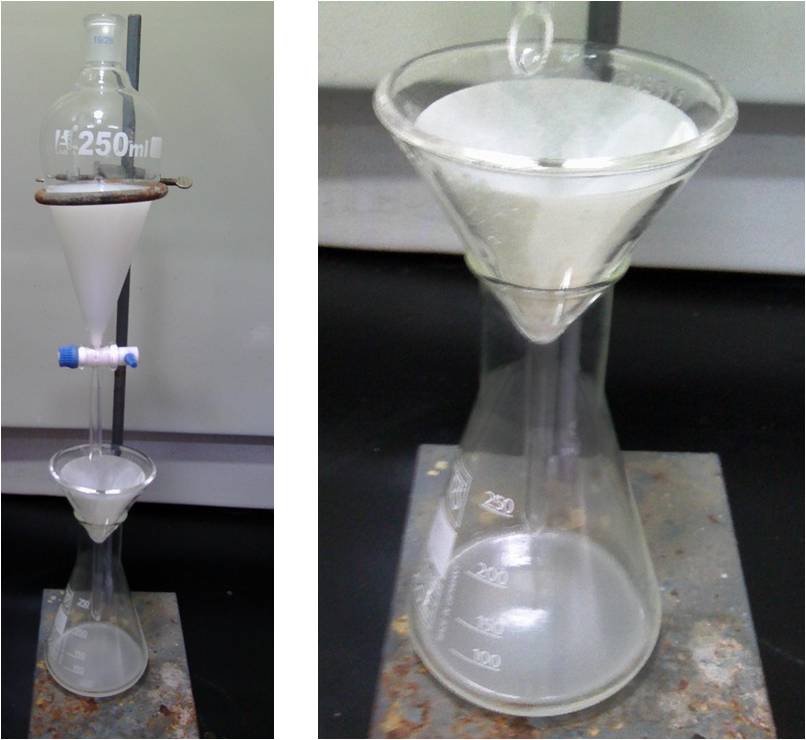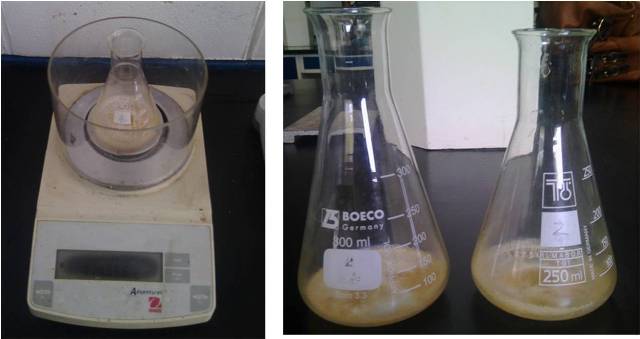Analysis of oils and fats in a wastewater sample

The fats and oils found in wastewater can have their origin from different sources, for example, at the domestic level, they come mostly from the preparation and use of food in our kitchens, it can also be observed how they are generated in industrial activities, in car workshops, oil changes, meat processing, thus contributing to environmental pollution.
When these pollutants are released, besides causing an aesthetic impact, they interfere with the development of biological life, if they are not treated before discharge, since they reduce the amount of oxygen in the aquatic environment and the transmission of light, causing the death of many organisms, additionally they cause problems for the maintenance of the sewage network and in the treatment systems used for water purification. Their determination is very useful for the design of systems that allow their treatment and elimination.
Basics of the method for the determination of oils and fats
First, a liquid-liquid extraction of the sample is carried out using an organic solvent, since the fat is soluble in it, and then the gravimetric method is applied.
Extraction process
Extraction is a method based on the difference in solubility of the compound to be separated in two different solvents. Extraction is achieved by the addition of a suitable organic solvent that is immiscible with water and can solubilize a large amount of the compound to be extracted. The mixture is then stirred, thus increasing the contact surface and achieving a more rapid distribution of the compound to be extracted between the two phases.
When left to stand, the two phases separate spontaneously by decantation, due to the difference in density between them, so that the organic phase containing the desired product is separated by simple decantation of the aqueous phase. Generally, after extraction, the aqueous phase still contains a certain amount of the compound, so the extraction process is usually repeated several times with the pure organic solvent in order to achieve maximum separation. After the extraction is finished, the organic solvent can be removed by distillation or evaporation.
Particle gravimetry
On the other hand, particle gravimetry by filtration is limited to analytes whose solid particles are easily separated from their matrix. For determinations of gas-phase analytes or solids that are not easily filtered, extraction can be used, provided that the analyte can be separated with a suitable solvent. After extraction, the solvent can be separated by evaporation and finally the mass of the extracted analyte is determined by weighing.
Method of analysis
Experimental part
Materials, equipment and reagents used
Materials used include separatory funnel, glass funnel, graduated cylinder, filter paper, erlenmeyer or flask, stirring rod, metal ring and universal stand.
Equipment: analytical balance, fume hood, oven.
Reagents: Chloroform, sodium sulfate.

Figure 2. Reagents and equipment used. Source: @yusvelasquez
Methodology used
The procedure consists of:
Sample preparation: measure with a graduated cylinder 150mL of the gray water sample, filter to remove suspended solids that the sample may contain to avoid the formation of emulsions and loss of analyte.

Figure 3. Sample preparation for analysis. Source: @yusvelasquez
Extraction: Transfer the water sample to the separatory funnel and add 5mL of chloroform. Shake the separatory funnel vigorously for approximately 5min.
Caution: During the agitation the pressure inside the funnel must be constantly released, this is achieved by removing the cap, since when agitating a volatile solvent its vapor pressure increases, which generates an overpressure in the funnel and can cause that the cap is released abruptly losing sample.
Allow to stand for approximately 10min for phase separation. Separate the organic extract and filter using a glass funnel with the filter paper moistened with sodium sulfate, collecting the filtrate in a previously weighed erlermeyer flask. To add 5mL of chloroform and to repeat the procedure until completing the addition of 15mL of chloroform.

Figure 4. Extraction. Source : @yusvelasquez
Drying and weighing: to take to oven to a temperature of 105 °C until constant weight. Allow to cool and weigh the dry residue.

Figure 5. Weighing. Source: @yusvelasquez
Expression of results
The oil and fat content is given by the weight increase and is expressed in mg/L. This method can be applied in the analysis of waste, surface, industrial or domestic water.
Application
Wastewater contains a large amount of substances, including oils and fats, which is why their determination is very important, in order to consider in the treatment system the necessary elements for their separation, which is generally included in the pretreatment stage are the grease traps, which allow the removal of these pollutants.
In their general form, these grease traps consist of small tanks where the grease is deposited on the surface, and the clear water exits through a discharge located at the bottom of the tank, and whose sizing depends on knowing the content of oils and fats in the wastewater stream by means of this type of analysis.
So much for the theoretical foundations and applications of particle gravimetry, I hope the information presented is useful, see you in a future post!
References
- Harvey, D. (2002). Modern Analytical Chemistry
- APHA-AWWA-WEF (2005). Standard Methods for the Examination of Water and Wastewater.
Your content has been voted as a part of Encouragement program. Keep up the good work!
Use Ecency daily to boost your growth on platform!
Support Ecency
Vote for Proposal
Delegate HP and earn more
Thank you!
Thanks for your contribution to the STEMsocial community. Feel free to join us on discord to get to know the rest of us!
Please consider supporting our funding proposal, approving our witness (@stem.witness) or delegating to the @stemsocial account (for some ROI).
Please consider using the STEMsocial app app and including @stemsocial as a beneficiary to get a stronger support.
thanks for your support